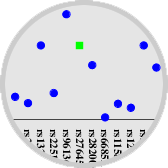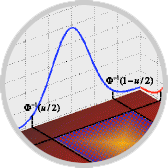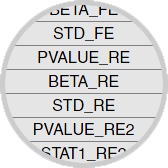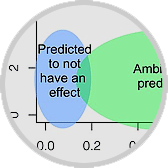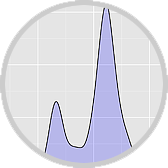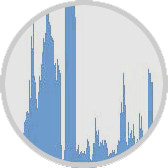Our group has developed numerous software packages that are actively supported. Read about our support software in relevant blog posts, and visit the software repository to learn more:
| ROP
Read origin protocol (ROP) is a computational protocol aimed to discover the source of all reads. The ‘dumpster diving’ profile of unmapped reads may be applied to whole-exome and whole-genome sequencing.
|
CAVIAR
CAusal Variants Identication in Associated Regions (CAVIAR) is a statistical framework that quantifies the probability of each variant to be causal while allowing with arbitrary number of causal variants.
|
| multiTrans
multiTrans is an efficient and accurate multiple testing correction approach for linear mixed models. It transforms genotype data to account for genetic relatedness and heritability under linear mixed models.
|
SLIP and SLIDE
Sliding-window method for Locally Inter-correlated markers with asymptotic Distribution Errors corrected (SLIDE) is a MVN-based multiple hypothesis testing correction method. Sliding-window method for Locally Inter-correlated markers for Power estimation (SLIP) is a MVN-based power estimation method.
|
| METASOFT
METASOFT is a free, open-source meta-analysis software tool for genome-wide association study analysis, designed to perform a range of basic and advanced meta-analytic methods in an efficient manner.
|
ForestPMPlot
ForestPMPlot is a python-interfaced R tool for analyzing the heterogeneous genetic effects on the phenotype in different study conditions in meta-analysis by visualizing the effect size differences between studies.
|
| PyLMM
PyLMM is a fast and lightweight python-based linear mixed-model solver for use in genome-wide association studies. It can also be used as a python module to build your own custom programs.
|
VGA
Viral Genome Assembler (VGA) is a method for accurate assembly of a heterogeneous viral population consisting of an individual’s viral genomes. VGA can eliminate errors from sequencing data.
|
| GAMMA
Generalized Analysis of Molecular variance for Mixed model Analysis (GAMMA) is a method that can simultaneously analyze many phenotypes as well as correct for population structure.
|
ASE
Allele-Specific Expression mapping (ASE) is a statistical framework that increases the computational power of eQTL with an alternative and complementary approach based on analyzing allele specific expression.
|
In addition, our group has developed many software packages and scripts that are available but no longer supported:
| EMMAX Efficient Mixed Model Association eXpedited (EMMAX) is a statistical test for large scale human or model organism association mapping accounting for the sample structure. http://genetics.cs.ucla.edu/emmax_jemdoc/ |
Hyun Min Kang hmkang [at] umich [dot] edu |
| EMMA Efficient Mixed Model Association (EMMA) is a statistical test for model organisms association mapping correcting for the confounding from population structure and genetic relatedness. http://mouse.cs.ucla.edu/emma_jemdoc/ |
Hyun Min Kang hmkang [at] umich [dot] edu |
| EMMA Study Design EMMA Power Simulation Package can estimate the threshold by generating null phenotypes and compute the statistical power using the random phenotypes with a simulated correlation structure. http://mouse.cs.ucla.edu/power_jemdoc/ |
Eun Yong Kang eunyong [dot] kang [at] gmail [dot] com |
| RAREVARIANTS Rare variant Weighted Aggregate Statistic (RWAS) and Likelihood Ratio Test (LRT) detect associations of groups of rare variants by working under the assumption that genotypes are generated with high confidence. http://genetics.cs.ucla.edu/rarevariants_jemdoc/ |
Jae Hoon Sul jaehoonsul [at] mednet [dot] ucla [dot] edu |
| POWERDESIGN POWERDESIGN is a webserver that efficiently designs a study to maximize statistical power given a genetic region of interest, by quickly aproximating the power of each candidate design. http://design.cs.ucla.edu/ |
Buhm Han buhm [dot] han [at] amc [dot] seoul [dot] kr |
| WHAP Weighted HAPlotype (WHAP) is a statistical test for case/control association studies that increases power of association studies by leveraging linkage disequilibrium patterns estimated from the HapMap. http://whap.cs.ucla.edu/ |
Noah Zaitlen noah [dot] zaitlen [at] ucsf [dot] edu |
| SPA Spatial Ancestry analysis (SPA) is a method for predicting ancestry or where an individual is from using the individual’s DNA. Accurately modeling ancestry is an important step in identifying genetic variation involved in disease. http://genetics.cs.ucla.edu/spa/ |
Eleazar Eskin eeskin [at] cs [dot] ucla [dot] edu |
| NICE Next-generation Intersample Correlation Emended (NICE) is a statistical test for correcting for expression heterogeneity inherent in expression dataset due to confounding from unmodeled factors. http://genetics.cs.ucla.edu/nice_jemdoc/ |
Jong Wha J Joo jwjoo1204 [at] gmail [dot] com |
| GRAT Genome-wide Rapid Association Testing (GRAT) is a two-stage testing procedure that identifies all of the significant associations more efficiently than testing all the SNPs. Efficient use increases the computational speed by a factor of 10. http://genetics.cs.ucla.edu/grat_jemdoc/ |
Emrah Kostem ekostem [at] cs [dot] ucla [dot] edu |
| GraphIBD GraphIBD is a free, open-source IBD association testing software for genome-wide association study analysis. GraphIBD requires an IBD detection method such as Beagle FastIBD to run first. http://genetics.cs.ucla.edu/graphibd/ |
Buhm Han buhm [dot] han [at] amc [dot] seoul [dot] kr |
| TEPAA Threshold-based Efficient Pairwise Association Approach (TEPAA) is a strategy to reduce the number of SNP pairs needed for epistasis detection while maintaing similar power with brute force approach. http://genetics.cs.ucla.edu/tepaa/ |
|
| CNVem CNVem aims to detect CNVs using HTS reads. We especially pay attention to the reads that map to multiple locations. In the current version of our software, we can only handle ONE chromosome. http://genetics.cs.ucla.edu/cnvem/ |
|
| HARSH HAplotype inference using Reference and Sequencing tecHnology (HARSH) is a method to infer the haplotype using haplotype reference panel and high throughput sequencing data. It is based on a novel probabilistic model and Gibbs sampler method. http://genetics.cs.ucla.edu/harsh/ |
Wen-Yun Yang wenyun [at] ucla [dot] edu |


